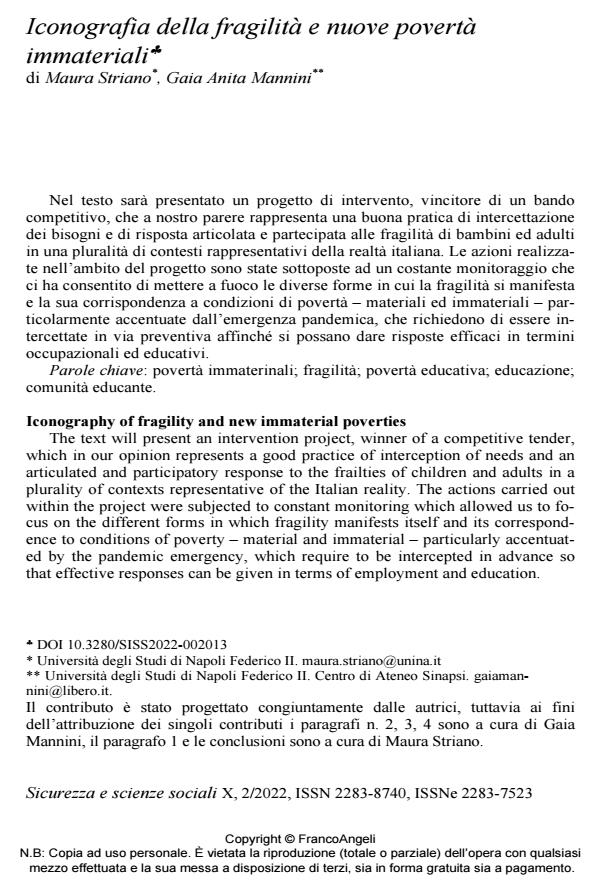Iconography of fragility and new immaterial poverties
Journal title SICUREZZA E SCIENZE SOCIALI
Author/s Maura Striano, Gaia Anita Mannini
Publishing Year 2022 Issue 2022/2 Language Italian
Pages 19 P. 185-203 File size 221 KB
DOI 10.3280/SISS2022-002013
DOI is like a bar code for intellectual property: to have more infomation
click here
Below, you can see the article first page
If you want to buy this article in PDF format, you can do it, following the instructions to buy download credits

FrancoAngeli is member of Publishers International Linking Association, Inc (PILA), a not-for-profit association which run the CrossRef service enabling links to and from online scholarly content.
The text will present an intervention project, winner of a competitive tender, which in our opinion represents a good practice of interception of needs and an articulated and participatory response to the frailties of children and adults in a plurality of contexts representative of the Italian reality. The actions carried out within the project were subjected to constant monitoring which allowed us to focus on the different forms in which fragility manifests itself and its correspondence to conditions of poverty - material and immaterial - particularly accentuated by the pandemic emergency, which require to be intercepted in advance so that effective responses can be given in terms of employment and education.
Keywords: immaterial poverty; fragility; children poverty; education; educating community.
- Bandura A. (2000). Autoefficacia: teoria e applicazioni. Roma: Erickson.
- Bateson G. (1972). Steps to an Ecology of Mind: Collected Essays in Anthropology, Psy-chiatry, Evolution, and Epistemology. Chicago: University of Chicago Press. (trad.it.: Verso un’ecologia della mente. Milano: Adelphi, 1977).
- Cialdini R. (1984). Influence. The Psychology of persuasion. New York: Quill William Morrow and Company, Inc. (trad.it Le armi della Persuasione. Firenze: Giunti, 1989).
- Ehrenberg, M. F., Cox, D. N., e Koopman, R. F. (1991). The relationship between self-efficacy and depression in adolescents. Adolescence, 26(102), 361–374.
- Freire P. (1971). La Pedagogia degli oppressi. Milano: Arnoldo Mondadori Editore.
- Freire P. (2004). Pedagogia dell’autonomia: saperi necessari per la pratica educativa. Torino: Edizioni gruppo Abele.
- Fruggeri L. (1998). Dal Costruttivismo al construzionismo sociale: implicazioni teoriche e terapeutiche. Psicobiettivo, vol. XVIII, 1.
- Gendlin E.T. (2012). Implicit precision. In Z. Radman. (Ed.): Knowing without thinking: The theory of the background in philosophy of mind. Basingstoke: Palgrave Macmillan.
- Giaconi C. (2008). Le vie del Costruttivismo. Roma: Armando Editore.
- Kirsch I. (1995). Self-Efficacy and Outcome Expectancies. In: Maddux, J.E. (eds) Self-Efficacy, Adaptation, and Adjustment. The Plenum Series in Social/Clinical Psychology. Springer, Boston, MA. DOI: 10.1007/978-1-4419-6868-5_1
- Kunz P. R., & Woolcott M. (1976). Season’s greetings: From my status to yours. Social Science Research, 5: 269-278. DOI: 10.1016/0049-089X(76)90003-X
- Lewin K.Z. 1972. I conflitti sociali. Saggi di dinamica di gruppo. Milano: FrancoAngeli.
- Maddux J. E. e Gosselin J. T. (2003). Self-efficacy. In M. R. Leary e J. P. Tangney (Eds.), Handbook of self and identity (pp. 218–238). New York: The Guilford Press.
- Mannini G.A. (2022), Semantica della fragilità per un nuovo lessico pedagogico: monito-raggio come strumento emancipativo. In: Musella M., Striano M., a cura di, “Openn: Offerta di Percorsi Educativi Nuovi. Un percorso interdisciplinare per il monitoraggio e la valuta-zione di impatto economico e socio-educativo di interventi per l’inclusione e il contrasto alla povertà educativa”. Napoli: Collana Nessuno Escluso-Sinapsi, in press.
- Marx K., Engels F. (1972). L’ideologia tedesca, in Montinari M., a cura di, Marx Engels Opere complete, a cura di M. Montinari. vol. V, Roma: Editori Riuniti.
- Mauss M. (1924). Essai sur le don. Forme et raison de l’échange dans les sociétés ar-chaïques in L’Année Sociologique, (trad.it. Saggio sul dono. Forma e motivo dello scambio nelle società arcaiche. Torino: Einaudi, 1965).
- Mezirow J. (2003). Apprendimento e trasformazione, Il significato dell’esperienza e il va-lore della riflessione nell’apprendimento degli adulti. Milano: Raffaello Cortina Editore.
- Musella M., Striano, M., a cura di. (2022). “Openn: Offerta di Percorsi Educativi Nuovi. Un percorso interdisciplinare per il monitoraggio e la valutazione di impatto economico e socio-educativo di interventi per l’inclusione e il contrasto alla povertà educativa”. Napoli: Collana Nessuno Escluso-Sinapsi, in press.
- Nussbaum M. (2012). Creare capacità. Liberarsi dalla dittatura del Pil. Bologna: il Mu-lino.
- Varisco B.M. (2002). Costruttivismo socio-culturale. Roma: Carocci.
- Von Bertalanffy L. (1968). General system theory. Foundations, development, applica-tions. London: Penguin (trad.it.: Teoria generale dei sistemi. Fondamenti, sviluppo e applica-zioni, Milano: Isedi, 1971).
- Wenger E. (1998). Communities of practice: learning, meaning and identity, New York: Cambridge University Press (trad.it.: Comunità di pratica. Apprendimento, significato e iden-tità. Milano: Raffaello Cortina editore, 2006)
- Zanelli P. (1993). Ricerca-azione: un modello “complesso” per la formazione nei servizi educativi. Bologna: Quaderni I.R.R.S.A.E – Formazione.
Maura Striano, Gaia Anita Mannini, Iconografia della fragilità e nuove povertà immateriali in "SICUREZZA E SCIENZE SOCIALI" 2/2022, pp 185-203, DOI: 10.3280/SISS2022-002013